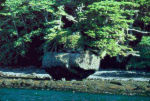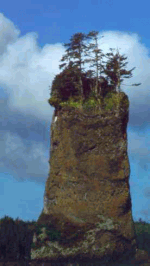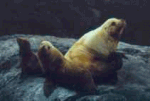written and photographed by Mary L. Peachin
Apr 2001, Vol. 5 No. 6
 Those in the know say that tiny, pristine Langara Island is not just about world-class salmon fishing. It’s got a lot of charm, for one, and views of isolated log-strewn beaches, old growth rainforest, rugged coastlines, and Pacific waters teeming with whales, seals, eagles fishing along side, black bears scavenging beaches; that are enough reason to visit.
Those in the know say that tiny, pristine Langara Island is not just about world-class salmon fishing. It’s got a lot of charm, for one, and views of isolated log-strewn beaches, old growth rainforest, rugged coastlines, and Pacific waters teeming with whales, seals, eagles fishing along side, black bears scavenging beaches; that are enough reason to visit.
 But then there are those who come for the salmon. Men (and a few women) from around the globe arrive at this dot on the map in tiny floatplanes, seeking one thing only: the mighty chinook. (Also the jumping coho, chum, pink, and even the occasional sockeye.) They come to fish the unpredictable currents of Langara’s jagged Pacific coastline. Others might just visit the rest of the Queen Charlotte archipelago—Moresby and Graham, plus hundreds of small uninhabited islands covered in lush northern rainforest. Together, they make up the home territory of the Haida First Nations peoples.
But then there are those who come for the salmon. Men (and a few women) from around the globe arrive at this dot on the map in tiny floatplanes, seeking one thing only: the mighty chinook. (Also the jumping coho, chum, pink, and even the occasional sockeye.) They come to fish the unpredictable currents of Langara’s jagged Pacific coastline. Others might just visit the rest of the Queen Charlotte archipelago—Moresby and Graham, plus hundreds of small uninhabited islands covered in lush northern rainforest. Together, they make up the home territory of the Haida First Nations peoples.
Unlogged, untouched Langara is a clear day’s view—about 30 miles—from southern Alaska. Here salmon congregate to feed prior to their long upriver journey, a trip that will batter and bruise them to eternity. The salmon in Langara are hungry; bulking up for their journey, and still in the prime of their life.
 Langara Lodge, a luxuriously converted 175-foot barge is moored in a cove on the south of the island. It is known mostly as a “guy’s place,” one where power-vacationing executives “play as hard as they work,” returning dozens of times (sometimes two or three times a summer) to Langara and to the salmon.
Langara Lodge, a luxuriously converted 175-foot barge is moored in a cove on the south of the island. It is known mostly as a “guy’s place,” one where power-vacationing executives “play as hard as they work,” returning dozens of times (sometimes two or three times a summer) to Langara and to the salmon.
In line with the clientele’s self-image, there’s little coddling: the morning wake-up knock reverberates down the hallway at five A.M. By six, the anglers are heading through the fog-filled Parry Passage for the 15-minute trip to the fishing grounds at Coho Point. Here, in one of the most remote and beautiful places in British Columbia, they meet up with the boats from three other lodges, all based in Henslung Cove. As eagles fish nearby, the boats huddle together, “mooching”—trolling just above idle speed. As the day progresses, the fishermen will follow the ebb or flood of the tide into waters where they hope “the bite” will happen.
 The angler’s journey to Langara begins in a Convair 530, which departs at the crack of dawn from the south terminal of Vancouver International airport. The two-hour flight heads north above the Inland Passage, revealing stunning views of the glaciated peaks of the coastal mountain range. Landing at Moresby Island’s Sandspit strip, the anglers are bussed 20 minutes to the Alliford Bay seaplane base. At the dock they board one of three 19-passenger DeHaviland Twin Otters.
The angler’s journey to Langara begins in a Convair 530, which departs at the crack of dawn from the south terminal of Vancouver International airport. The two-hour flight heads north above the Inland Passage, revealing stunning views of the glaciated peaks of the coastal mountain range. Landing at Moresby Island’s Sandspit strip, the anglers are bussed 20 minutes to the Alliford Bay seaplane base. At the dock they board one of three 19-passenger DeHaviland Twin Otters.
No sooner has the floatplane tied up at the lodge’s dock than orientation begins. There’s a quick review of the catching limits for each fish taken—procedures for salmon that will be cleaned, filleted, and flash-frozen or canned. Then it’s on to the locker room, to pick up rubber boots and bright red survivor suits (for emergency floatation as well as weather protection).
 General manager Bill Gibson gives a quick safety talk, emphasizing the lodge’s policy against beach landings for bathroom stops: “Most drowned men have been found with their zippers down.” I chuckle and a nearby gentleman asks why I am laughing. “Just jealous,” I respond, knowing that as the trip’s lone female, my only option is a bucket. Bill talks about the most effective use of the herring bait (it needs to spin), and how fishing lines should drift at a 45-degree angle. He runs through the “flex day schedule,” which permits anglers to fish from five in the morning to nine at night. Anglers can return to the lodge for meals at any time, or for coffee from its new espresso bar—although the true diehards rely on the twice-daily sandwich run, courtesy of an orange Zodiac that doubles as the safety boat.
General manager Bill Gibson gives a quick safety talk, emphasizing the lodge’s policy against beach landings for bathroom stops: “Most drowned men have been found with their zippers down.” I chuckle and a nearby gentleman asks why I am laughing. “Just jealous,” I respond, knowing that as the trip’s lone female, my only option is a bucket. Bill talks about the most effective use of the herring bait (it needs to spin), and how fishing lines should drift at a 45-degree angle. He runs through the “flex day schedule,” which permits anglers to fish from five in the morning to nine at night. Anglers can return to the lodge for meals at any time, or for coffee from its new espresso bar—although the true diehards rely on the twice-daily sandwich run, courtesy of an orange Zodiac that doubles as the safety boat.
Before lunch and the day’s first catch, assistant manager (and serious competitive angler) Suzanne Lopez greets old friends, directing everyone to their assigned (smallish, but nicely decorated) rooms, each with a private bath.
 Anglers have the choice of cutting their own bait (herring) or paying extra for a guide, someone who knows these waters and takes care of the lines and bait. On my way to my room, I’m stopped by my guide Ian Hickenbotham, a tall, burly man with a smile that reaches to his ears. He welcomes me, then asks several questions about my fishing experience and my personal conservation philosophy (I practice mainly catch-and-release fishing).
Anglers have the choice of cutting their own bait (herring) or paying extra for a guide, someone who knows these waters and takes care of the lines and bait. On my way to my room, I’m stopped by my guide Ian Hickenbotham, a tall, burly man with a smile that reaches to his ears. He welcomes me, then asks several questions about my fishing experience and my personal conservation philosophy (I practice mainly catch-and-release fishing).
The Langara guides don’t exaggerate when they talk about the sheer numbers of salmon that pass the islands. In two full and two half days, I caught and released 45 chinook, coho, pink, and chum salmon. But there was plenty going on between casts. Several times, Ian spotted a whale spout and we pulled in the fishing lines and headed to nearby “Humpback Alley” for some whale watching, quietly following the huge creatures until they sounded with a flip of their enormous tails.
 During my visit, the west side of Langara Island was closed to anglers because of high waves and strong currents. One afternoon, when the waves settled down a bit, we were able to make the trip around the island—not to fish, just to explore. It turns out that a lighthouse still operates on the west coast; a hundred feet above is the concrete foundation that anchored a nearby storage building, since battered into oblivion by winter storms. Wherever we looked that day, we saw incredible sealife: peregrine falcons, sea lions, tufted puffins. In a picturesque cove, a Sitka blacktail deer grazed along the edge of the beach.
During my visit, the west side of Langara Island was closed to anglers because of high waves and strong currents. One afternoon, when the waves settled down a bit, we were able to make the trip around the island—not to fish, just to explore. It turns out that a lighthouse still operates on the west coast; a hundred feet above is the concrete foundation that anchored a nearby storage building, since battered into oblivion by winter storms. Wherever we looked that day, we saw incredible sealife: peregrine falcons, sea lions, tufted puffins. In a picturesque cove, a Sitka blacktail deer grazed along the edge of the beach.
Another day, on a beach in Bruin Bay, we spotted a black bear sow with her newborn cub. As the cub bleated for a morsel, she shimmied up a tree, helping herself to food cached there by campers staying at the nearby Haida First Nations campsite. At another beach, a male bear tore through piles of seaweed, looking for bugs and grubs.
 Landmarks in the Charlottes tend to take the form of interestingly shaped rocks, frequently topped by trees and evocatively named things like Flower Pot and Pillar. Many of the beaches are covered in bark-stripped logs, tossed there like toothpicks by winter storms.
Landmarks in the Charlottes tend to take the form of interestingly shaped rocks, frequently topped by trees and evocatively named things like Flower Pot and Pillar. Many of the beaches are covered in bark-stripped logs, tossed there like toothpicks by winter storms.
The flora and fauna served as wonderful distractions from some of the best salmon fishing I’ve experienced in thirty years of casting a line. I could tell by the feel of my first bite—I hooked into a 30-pound Chinook (also called a Tyee) using a single-action mooching reel of 20-pound test line on a ten-and-a-half-foot rod. The strength of this beautiful fish was unbelievable, as were the jumping and running tactics of the coho.
 The guests—me included—may have been devoted to the fishing, but we made time for other pleasures, dining leisurely on the gourmet cooking of chef Jean Peters. Our last night, we feasted until nearly midnight on wine, escargot, fresh fish, steaks, and crème brulee. The next morning, I watched as, one by one, the men dropped off to sleep before the plane to Vancouver had left the runway. I stayed awake, my thoughts drifting pleasurably between the meal, the fishing, and the beauty of Langara.
The guests—me included—may have been devoted to the fishing, but we made time for other pleasures, dining leisurely on the gourmet cooking of chef Jean Peters. Our last night, we feasted until nearly midnight on wine, escargot, fresh fish, steaks, and crème brulee. The next morning, I watched as, one by one, the men dropped off to sleep before the plane to Vancouver had left the runway. I stayed awake, my thoughts drifting pleasurably between the meal, the fishing, and the beauty of Langara.
If you go:
Vancouver is the gateway city to the Queen Charlottes. Langara operates their own flight charter from the South Terminal. An overnight stay is usually necessary on both ends of the trip.
Airport Hotels:
Delta Vancouver Airport Hotel, 3500 Cessna Drive, Richmond, BC (800) 268-1134, (604) 278-1241 (604) 276-1975, Fax www.deltahotels.com/hotels.php3?action=show&hotelid=9
The Fairmont Vancouver Airport (conveniently located in the international terminal) 3111 Grant McConachie Way, Vancouver International Airport (604) 207-5200 tel (604) 248-3219 FAX www.fairmont.com/
City hotels:
Delta Pinnacle Hotel 1128 West Hastings Street (604) 684-1128 (604) 298-1128, FAX www.deltahotels.com/hotels.php3?action=show&hotelid=32
Listel-Vancouver Hotel 1300 Robson Street at Jervis (800) 663-5491 [email protected] www.listel-vancouver.com/
Wedgewood Hotel 845 Hornby Street (800) 663-0666, (604) 689-7777 (604) 608-5348, Fax [email protected] www.wedgewoodhotel.com
